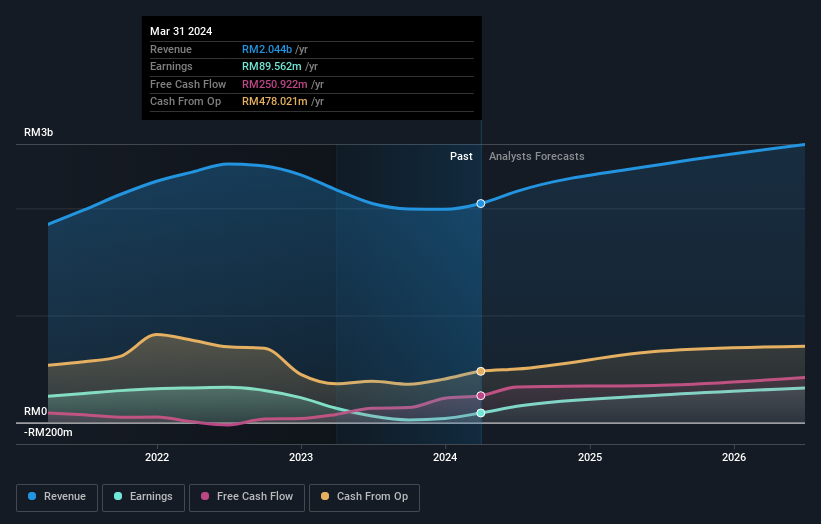While institutions own 25% of Malaysian Pacific Industries Berhad (KLSE:MPI), private companies are its largest shareholders with 59% ownership
Key Insights
Significant control over Malaysian Pacific Industries Berhad by private companies implies that the general public has more power to influence management and governance-related decisions
The largest shareholder of the company is Hong Leong Company (Malaysia) Berhad (Hlcm) with a 58% stake
Institutional ownership in Malaysian Pacific Industries Berhad is 25%
Every investor in Malaysian Pacific Industries Berhad (KLSE:MPI) should be aware of the most powerful shareholder groups. And the group that holds the biggest piece of the pie are private companies with 59% ownership. Put another way, the group faces the maximum upside potential (or downside risk).
Institutions, on the other hand, account for 25% of the company's stockholders. Institutions often own shares in more established companies, while it's not unusual to see insiders own a fair bit of smaller companies.
Let's take a closer look to see what the different types of shareholders can tell us about Malaysian Pacific Industries Berhad.
View our latest analysis for Malaysian Pacific Industries Berhad
What Does The Institutional Ownership Tell Us About Malaysian Pacific Industries Berhad?
Institutional investors commonly compare their own returns to the returns of a commonly followed index. So they generally do consider buying larger companies that are included in the relevant benchmark index.
As you can see, institutional investors have a fair amount of stake in Malaysian Pacific Industries Berhad. This can indicate that the company has a certain degree of credibility in the investment community. However, it is best to be wary of relying on the supposed validation that comes with institutional investors. They too, get it wrong sometimes. When multiple institutions own a stock, there's always a risk that they are in a 'crowded trade'. When such a trade goes wrong, multiple parties may compete to sell stock fast. This risk is higher in a company without a history of growth. You can see Malaysian Pacific Industries Berhad's historic earnings and revenue below, but keep in mind there's always more to the story.
Hedge funds don't have many shares in Malaysian Pacific Industries Berhad. The company's largest shareholder is Hong Leong Company (Malaysia) Berhad (Hlcm), with ownership of 58%. This implies that they have majority interest control of the future of the company. In comparison, the second and third largest shareholders hold about 5.5% and 3.5% of the stock.
While it makes sense to study institutional ownership data for a company, it also makes sense to study analyst sentiments to know which way the wind is blowing. Quite a few analysts cover the stock, so you could look into forecast growth quite easily.
Insider Ownership Of Malaysian Pacific Industries Berhad
The definition of an insider can differ slightly between different countries, but members of the board of directors always count. The company management answer to the board and the latter should represent the interests of shareholders. Notably, sometimes top-level managers are on the board themselves.
Most consider insider ownership a positive because it can indicate the board is well aligned with other shareholders. However, on some occasions too much power is concentrated within this group.
We can report that insiders do own shares in Malaysian Pacific Industries Berhad. It is a pretty big company, so it is generally a positive to see some potentially meaningful alignment. In this case, they own around RM79m worth of shares (at current prices). Most would say this shows alignment of interests between shareholders and the board. Still, it might be worth checking if those insiders have been selling.
General Public Ownership
The general public-- including retail investors -- own 15% stake in the company, and hence can't easily be ignored. While this group can't necessarily call the shots, it can certainly have a real influence on how the company is run.
Private Company Ownership
It seems that Private Companies own 59%, of the Malaysian Pacific Industries Berhad stock. It's hard to draw any conclusions from this fact alone, so its worth looking into who owns those private companies. Sometimes insiders or other related parties have an interest in shares in a public company through a separate private company.
Next Steps:
It's always worth thinking about the different groups who own shares in a company. But to understand Malaysian Pacific Industries Berhad better, we need to consider many other factors.
I always like to check for a history of revenue growth. You can too, by accessing this free chart of historic revenue and earnings in this detailed graph.
But ultimately it is the future, not the past, that will determine how well the owners of this business will do. Therefore we think it advisable to take a look at this free report showing whether analysts are predicting a brighter future.
NB: Figures in this article are calculated using data from the last twelve months, which refer to the 12-month period ending on the last date of the month the financial statement is dated. This may not be consistent with full year annual report figures.
Have feedback on this article? Concerned about the content? Get in touch with us directly. Alternatively, email editorial-team (at) simplywallst.com.
This article by Simply Wall St is general in nature. We provide commentary based on historical data and analyst forecasts only using an unbiased methodology and our articles are not intended to be financial advice. It does not constitute a recommendation to buy or sell any stock, and does not take account of your objectives, or your financial situation. We aim to bring you long-term focused analysis driven by fundamental data. Note that our analysis may not factor in the latest price-sensitive company announcements or qualitative material. Simply Wall St has no position in any stocks mentioned.
Have feedback on this article? Concerned about the content? Get in touch with us directly. Alternatively, email editorial-team@simplywallst.com

 Yahoo Finance
Yahoo Finance 

